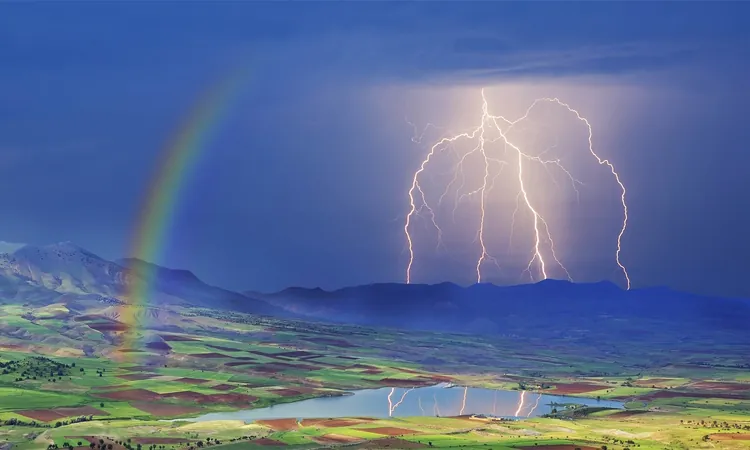
The Carnian Pluvial Episode: How a Million-Year Deluge Birthed the Age of Dinosaurs
2024-11-17
Author: Lok
The Carnian Pluvial Episode: How a Million-Year Deluge Birthed the Age of Dinosaurs
Around 233 million years ago, the Earth underwent a dramatic transformation. During the Late Triassic period, all modern continents were joined as one colossal supercontinent known as Pangea, encircled by the vast Panthalassa Ocean. Life was on the cusp of a significant change, thanks to a remarkable climatic shift commonly referred to as the Carnian Pluvial Episode (CPE).
Recently, an international team of scientists, including Dr. Jacopo Dal Corso from the China University of Geosciences and Professor Mike Benton from the University of Bristol, made groundbreaking discoveries regarding this pivotal moment in our planet's history. Their research sheds light on a major extinction event that ultimately allowed dinosaurs to flourish and dominate terrestrial ecosystems.
The Carnian Pluvial Episode: What Triggered the Change?
During a prolonged dry spell, conditions suddenly shifted as extensive volcanic eruptions in the Wrangellia Province—an area now encompassing parts of Alaska and British Columbia—unleashed vast amounts of carbon dioxide into the atmosphere. This led to a rise in global temperatures by approximately 5 to 7 degrees Fahrenheit, triggering rectifying climate changes that fueled extensive rainfall worldwide.
The fossil evidence gathered from the Northern Limestone Alps in Austria pointed to an era of wet conditions, sandwiched between periods of aridity. This surprising shift resulted in a mass extinction event; many life forms could not adapt to the drastic climate changes. Yet, out of this chaos, new species began to emerge, filling ecological niches left vacant by the disappearing species.
Dinosaurs Rise: Evolution in Action
Initially, dinosaurs had existed for about 20 million years prior to the CPE but remained relatively obscure in the face of competing species. However, the humid conditions paved the way for their ascent. As the climate gradually shifted back to drier conditions, these formidable creatures took full advantage of their newfound dominance. The period also marked the emergence of turtles, crocodiles, lizards, and some of the first mammals.
This era saw a flourishing of conifer forests, expanding habitats and supporting diverse life forms. Oceans, too, experienced profound changes; this marked the dawn of modern coral reefs and diverse plankton species, crucial for the marine food chain.
Recognizing a Sixth Mass Extinction
Historically, paleontologists have recognized five major mass extinction events that dramatically reshaped biodiversity on Earth. However, the CPE has now been identified as another significant extinction event in Earth's history. The findings from Dr. Dal Corso and his team highlight how this ancient event acted as a reset button, leading to the beginnings of modern ecosystems we recognize today.
Lessons for a Changing World
The implications of the Carnian Pluvial Episode are profound, especially in light of the ongoing climate crisis. As human activities continue to increase greenhouse gas emissions, understanding how ecosystems historically responded to rapid environmental changes provides vital insights for contemporary conservation efforts.
Research into events like the CPE reinforces the importance of interdisciplinary collaboration among geologists, paleontologists, and climate scientists. As we strive for solutions to our pressing environmental challenges, the geologic past offers critical lessons about resilience and adaptability—qualities that life on Earth will need in the face of anthropogenic climate change.
The findings surrounding the Carnian Pluvial Episode were published in the prestigious journal PNAS, marking a significant advancement in our understanding of Earth's complex history and the interlinked processes that have shaped life through the ages.
As we unveil more secrets from our planet's past, every discovery holds the promise of informing our future as we navigate the evolving challenges of climate change and environmental stewardship.

 Brasil (PT)
Brasil (PT)
 Canada (EN)
Canada (EN)
 Chile (ES)
Chile (ES)
 España (ES)
España (ES)
 France (FR)
France (FR)
 Hong Kong (EN)
Hong Kong (EN)
 Italia (IT)
Italia (IT)
 日本 (JA)
日本 (JA)
 Magyarország (HU)
Magyarország (HU)
 Norge (NO)
Norge (NO)
 Polska (PL)
Polska (PL)
 Schweiz (DE)
Schweiz (DE)
 Singapore (EN)
Singapore (EN)
 Sverige (SV)
Sverige (SV)
 Suomi (FI)
Suomi (FI)
 Türkiye (TR)
Türkiye (TR)